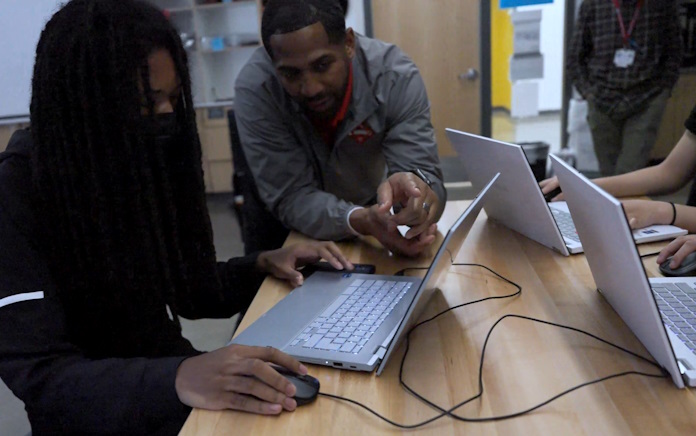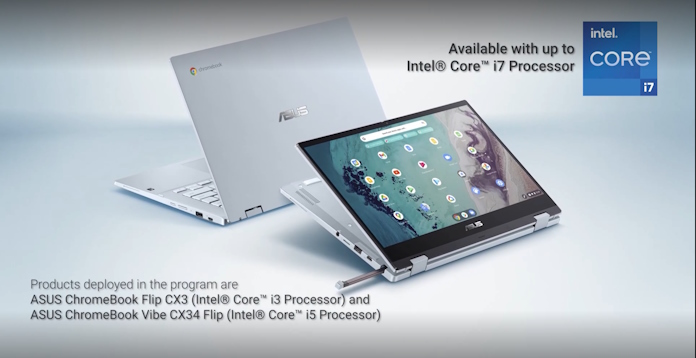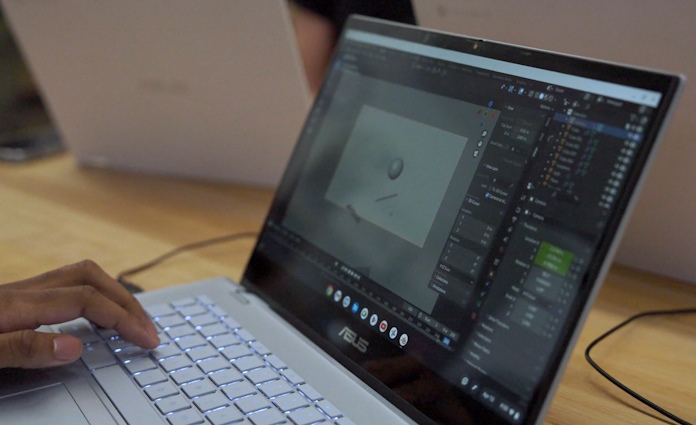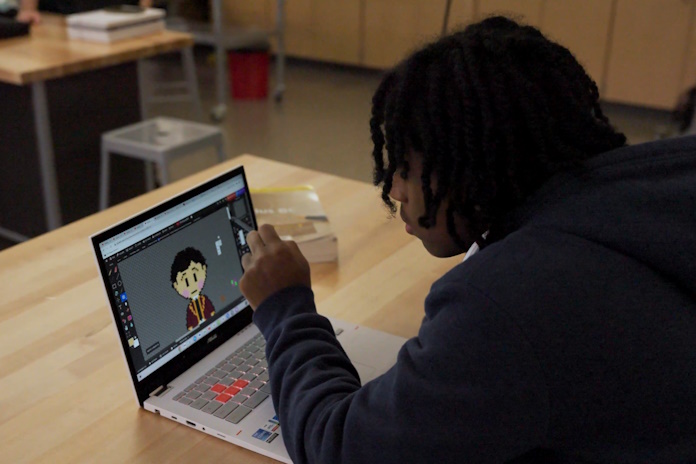Lavar Askew, a software architect at Intel, doesn’t have to look far to find an example of how a teenager can make a large impact. In 1979, Intel hired an 18-year-old named Pat Gelsinger — and now, 44 years later, he’s the international chip giant’s CEO.
That’s one reason why Lavar mentors high school students and helps connect them with life-changing opportunities. But it’s not the only reason. As a young man, he had a passion for STEM, but didn’t know what to do with it. “When I was a kid, I was always told that an engineer was someone who drove trains,” he recalled. “And even though I had a liking for math and science, I just didn’t know where I could go to find out more about it.”
Giving back at McDaniel
Today, Lavar leads a program at McDaniel High School in Portland, Oregon called “Inclusion in Tech” that gives students the direction and guidance that he didn’t always have as a young man. As one of Oregon’s most diverse high schools, McDaniel has no shortage of talent, yet the community it serves has too many kids with limited opportunities to hone their talents using cutting-edge devices.

When Lavar started working with McDaniel students, he was stunned by how much they knew before he even walked in the door. “One of the things that I noticed right off the bat is that I don’t have to teach them anything,” he said. “They already know how Blender works. They already know how Sketchbook works. Many of them already understand calculus.”
What the students were missing was access to computers that could keep up with their ambitions. Lavar explains, “What I felt like I needed to do was get some of the devices that I saw in the lab, like the ASUS Chromebook Flip CX3 3400, and I needed to provide those machines to the students.”
With these devices in hand, Lavar was able to capture the attention of McDaniel’s students — and help them see their opportunities in the world of tech. He explained, “I started it off as kind of a trick. ‘Hey, come play video games and draw pictures and tell me what you think.’ But really, what I wanted to do was to get students to understand that the knowledge they’re learning from teachers every day that seems so boring is absolutely key to the success of tech companies today.”
The right tech creates new opportunities
Schools around the country use Chromebooks for classroom activities, and it’s not hard to understand why. These affordable devices are easy to deploy and easy to manage. Yet not all Chromebooks are built to empower the ambitions of high school STEM enthusiasts.

Antonio Jackson, an educator and the founder of the non-profit organization Building Blocks 2 Success (BB2S), works as a community manager in this project between Intel and McDaniel High School. His years of experience working with underrepresented youth have shown him clearly what these students need from a laptop as they explore their interests and develop career skills.
“The one thing about young people is they get equipment and they’re trying to break it,” Antonio explains. “They’re trying to figure out how this all works. They’ll have so many things running. They’re always trying to test the limits, and you can only test the limits when you have equipment that you’re able to push to the limits.”
Enter the ASUS Chromebook CX34 Flip
McDaniels High School needed a set of laptops that could do more, so they selected a set of our latest ASUS Chromebook CX34 Flip laptops. These powerful devices use the secure, easy to manage ChromeOS environment that the students, teachers, and IT staff were familiar with, but they’re equipped for amazing STEM experiences with 12th Gen Intel Core CPUs.

“ASUS Chromebooks have been amazing,” Antonio said. “Students were able to do more things. They were able to feel more confident to do gaming, to do art, to just navigate because it had more power.”
One student, Kelly Leoung, explained how the CX34 Flip was an asset for her biomed class: “We have to use a lot of sources in our projects, so if I can switch between tabs seamlessly, that would take me much less time.” The CX34 Flip’s potent processor, plentiful RAM, and speedy storage drive make all the difference for students who need to multitask.
The Chromebook CX34 Flip’s touchscreen and 360° hinge prove invaluable for students with interests in game development, character design, and digital art. It’s easy to flip the screen over into stand mode and sketch out an idea in Sketchbook using the garaged stylus. Students praised the display’s vibrant colors, and not just for their interest in gaming. Tyson Nguyen commented that the display “really helped me with digital design and it just showed a new path to me, because I’m not really good at art, but I just like doing it.” Perhaps Tyson isn’t confident with creating art right now, but time with professional-grade tools just might open unexpected possibilities down the road.
Putting the learning experience first
As Lavar was looking for the right Chromebooks for the students at McDaniel High School, he had to work against conventional wisdom. He explained, “Normally what IT decision makers want from a Chromebook is repairability and durability. But what I’m trying to do is put engagement at the forefront, like how the device actually handles with the students and the teachers.”
School districts know that durability is essential. Kids aren’t always gentle with school laptops, so their classrooms are typically equipped with highly repairable devices that are built to go the distance. “It’s not that durability and repairability aren’t important,” Lavar clarified, “but they shouldn’t be more important than the learning needs of the students.” In the Chromebook CX34 Flip, Lavar identified a laptop that offered the performance and features he needed to engage his students and the durability that the school’s IT decision makers required.

Erica Spencer, McDaniel High School’s guidance counselor, saw first-hand what her students could do when they were given access to higher-performance devices. “Some of the students were not interested, didn’t think they would be interested in technology and computers. But it all changed,” she recalled. “Once they went through the program, they became more interested. They saw the different things that they could do. Just talking to students, they seemed more interested and engaged.”
Students benefit from high-performance hardware
Today’s high school students have a wide range of exciting career opportunities ahead of them in science, technology, engineering, and mathematics. Yet too many kids lack the opportunity to realize how talented they are — and how much today’s tech companies need their skills, passion, and creativity. That’s why we support digital inclusion initiatives around the world to promote digital equity, regardless of education status, gender, ethnicity, and other key socioeconomic factors.

As Lavar thinks about the prospects ahead of his students at McDaniel High School, his mind keeps returning to the example of his CEO. “Pat Gelsinger is the CEO of Intel. He joined Intel at 18 years old,” Lavar said. “One of the questions that I ask myself is, where would Intel be without an 18-year-old Pat? Well, I got some kids. They’re 14 and I think they’re little Pats. I think there’s more out there. And I think that these kids have more to contribute to the world right now. We don’t have to wait until they graduate from college, from undergrad, in order to employ them or make them interns or mentor them. I say, I think we should just start right now. Start where they are.”

